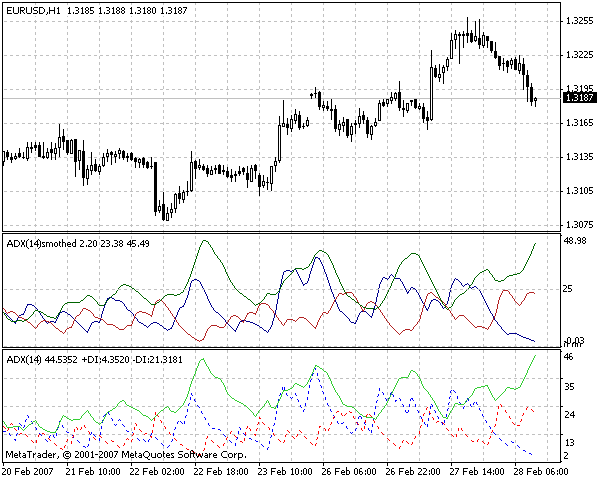Join our fan page
- Views:
- 40107
- Rating:
- Published:
- Updated:
-
Need a robot or indicator based on this code? Order it on Freelance Go to Freelance
Indicator Smoothed ADX was written on demand of a forum visitor and was not too difficult. However, the search for a description of the smoothed ADX algorithm resulted in nothing. This is why I give below only the code that has been provided:
Inputs: {declaring inputs}
Length( 14 ),
ADXTrend( 25 ), alpha1(0.25), alpha2(0.33);
DMIPlus( 0 ), DMIMinus( 0 ), DMI( 0 ), ADX( 0 ),
DIPlusLead(0), DIMinusLead(0), DIPlusFinal(0), DIMinusFinal(0),
ADXLead(0), ADXFinal(0);
DIPlusFinal = alpha2*DIPlusLead + (1 - alpha2) * DIPlusFinal[1];
DIMinusFinal = alpha2*DIMinusLead + (1 - alpha2) * DIMinusFinal[1];
ADXFinal = alpha2*ADXLead + (1 - alpha2) * ADXFinal[1];
Plot3( ADXFinal, "ADX" ) ;
Indeed, if you don't try to get into the deep sense underlying the initial text of the smoothed ADX, this smoothing can be divided into two stages. Suppose we have a numerical sequence P and we have to smooth it with a minimum lag. For this, we build at the first stage function V(P) of P-sequence oscillation from the following formula:
V0 = (8*P0 - 7*P1 + 3*V1) / 4,
where:
- P0 is the current value of the sequence (a price or an indicator);
- P1 is the preceding value of the sequence;
- V1 is the preceding value of oscillation;
- V0 is the current value of oscillation.
Or, in a different way:
V0 = (Vol(P) + 3*V1) / 4,
where:
Vol(P) = 8*P0 - 7P1 - Ehlers' burst (the term is invented by myself).
At the second stage, we apply the simple weighted smoothing:
W0 = (1*V0 + 2*W1) / (2 + 1).
where:
- W0 is the current smoothed value of sequence P;
- V0 is the current value of P-sequence oscillation;
- W1 is the preceding smoothed value.

Translated from Russian by MetaQuotes Ltd.
Original code: https://www.mql5.com/ru/code/7072
 Spearman's Rank Correlation
Spearman's Rank Correlation
Spearman's Rank Correlation is a non-parametric method used in order to make statistical studies of relations between phenomena. In this case, the factual degree of parallelism between two numeric sequences will be detected.
 Center of Gravity by J. F. Ehlers
Center of Gravity by J. F. Ehlers
Center of Gravity is an oscillator developed by John F. Ehlers and presented in his article in Stocks & Commodities magazine (May 2002).